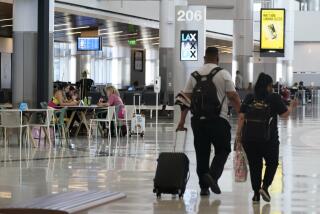Fliers’ Complaints Against Airlines Rise 16.5% in 1994 : Performance: Of major U.S. carriers, Continental provoked the most, Southwest the least, according to report.
- Share via
Last year’s consumer complaints have been counted at the federal Department of Transportation, and though the airline industry’s traffic is up, consumers have decidedly mixed feelings about what they’re getting.
Complaints to the department about this country’s airlines rose 16.5% last year, the department’s annual Air Travel Consumer Report shows--from 4,444 airline complaints in 1993 to 5,179 in 1994. (Complaints against the nine largest U.S. carriers rose from 3,714 to 3,745, but the number of passengers carried rose at a steeper rate.) Complaint categories included customer service, ticketing/boarding, fares, baggage and the broad category of “flight problems,” which takes in delays, cancellations and missed connections.
“Obviously, when the numbers go up that troubles us,” said Chris Chiames, spokesman for the Air Transport Assn., lobbying organization for the U.S. airline industry. But Chiames also noted a general downward trend of complaints over major carriers in the last decade and suggested that the 1994 figures may reflect the intense scrutiny focused on airlines last year after several heavily publicized crashes. This country’s major and commuter airlines had seven fatal accidents involving 264 deaths in 1994, Chiames said. In 1993, he said, there were five such accidents and 25 deaths.
Other year-end figures show that major airlines’ on-time performance held steady in 1994, while complaints about baggage handling fell slightly. All told, 471.1 million passengers boarded flights last year on the country’s nine largest airlines, an increase of about 6% over 1993.
The busiest carrier was Delta, with 88.9 million passengers, followed by American (81.1 million), United (74.2 million), USAir (59.8 million), Northwest (45.6 million) and Southwest (44.4 million).
It’s easy to read too much into Transportation Department complaint figures. They reflect only the travelers who take the trouble to lodge their complaints with the department, and they exclude safety-related complaints, which the Federal Aviation Administration handles. But some clear trends emerge in the year-end figures, and travelers may well benefit from recognizing them.
Continental Airlines, for instance, provoked 864 complaints, more than any other major carrier by a substantial margin, even though six other airlines carried more passengers than Continental did. In the government’s separate tally of reports filed over mishandled baggage, Continental again ran last, recording 6.59 such reports per 1,000 passengers. (The average among major carriers was 5.33 reports per 1,000 passengers.) And in the government’s assessment of on-time performance, Continental ranked last yet again, with 78.8% of its flights arriving within 15 minutes of their scheduled times. (The average among the top 10 was 81.5%, down a tick from 81.6% in 1993.)
Meanwhile, at the other end of those charts, there’s Southwest Airlines, now the fifth-busiest carrier in the country. Boldly proclaiming its no-frills approach--and thus conditioning travelers to lower their expectations--that carrier provoked just 104 complaints, substantially fewer than any other major carrier. Southwest also was named in fewer mishandled baggage reports than any other major carrier (4.16 reports per 1,000 passengers) and posted the best on-time record among the majors. Southwest’s on-time average for the year was 86.6%.
Transportation Secretary Federico Pena has announced plans to more heavily emphasize the department’s consumer protection efforts--an encouraging idea, but one tinged by irony: At the same time Pena was announcing his concern over deceptive ads and proclaiming new vigor in the department’s Office of Consumer Protection, a department spokesman acknowledges that the office’s staff was being cut from 14 to 10.
Pena has voiced concern about several airline promotional strategies, and how they can lead to deceptive practices. For instance, once a fare is advertised in a certain market, transportation officials recently affirmed, carriers are obligated to make “reasonable numbers” of seats available at that price in the area. Similarly, in running their frequent-flier programs, carriers are warned not to impose “unreasonable” capacity restrictions or unannounced blackout dates that limit use of frequent-flier awards.
But a spokesman acknowledges that in both cases, the department has not defined what is reasonable. (At the Air Transport Assn., Chiames says that many industry officials have informally settled on the idea that if a special fare is advertised, at least 10% of the eligible seats on flights involved should be made available at the advertised fare.)
Nevertheless, Pena’s new campaign has already scolded one carrier for transgressions in advertising. In January, federal officials fined Continental Airlines $38,000 for failing to disclose fuel surcharges in its fare advertising from July to November of last year, and required the airline to distribute at least 60,000 discount travel coupons to travelers between Florida and New York. Continental officials noted that the surcharge was only $2, and said it had been omitted in a clerical error.
Reynolds travels anonymously at the newspaper’s expense, accepting no special discounts or subsidized trips. To reach him, write Travel Insider, Los Angeles Times, Times Mirror Square, Los Angeles 90053.
More to Read
Inside the business of entertainment
The Wide Shot brings you news, analysis and insights on everything from streaming wars to production — and what it all means for the future.
You may occasionally receive promotional content from the Los Angeles Times.











